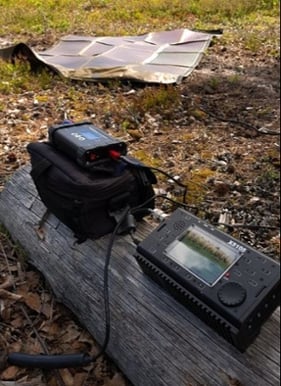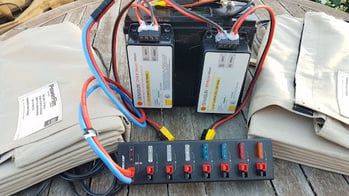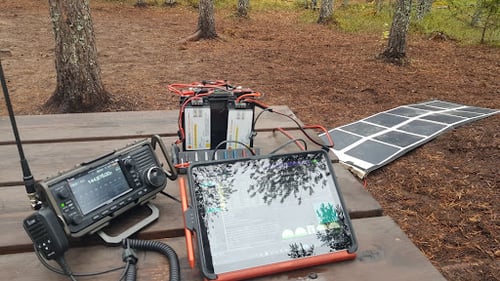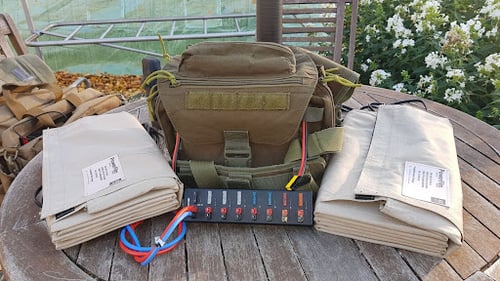How To Power Your Ham Radio with Portable and Lightweight Solar Panels
.jpg?width=500&height=300&name=How%20To%20Power%20Your%20Ham%20Radio%20with%20Portable%20and%20Lightweight%20Solar%20Panels%20(500%20x%20300).jpg)
Originally published 10-6-2020.
In today’s post, PowerFilm Ambassador Julian White, OH8STN, explores power's role in portable communications by looking at the different aspects of a portable ham radio setup.
Take this blog post with you!
Benefits of solar for portable ham radio operations
Traditionally, operators deploying lead-acid batteries would carry “enough” battery storage to last the day. Unfortunately, there wasn’t a man-portable way to recharge that pack in the field if there was a greater demand for their energy supply.
Lightweight thin-film solar panels allow the operator to choose smaller batteries, reducing their weight without reducing operating time.
With lithium technologies and thin-film panels, we start the deployment with a full battery pack. The solar panel’s job is to keep the battery topped up. We use our battery storage during darkness, augmenting our solar panels when there’s no sun.
Before we dig into the different aspects of a portable solar solution for ham radio, we must clearly understand our power budget. A well-thought-out power budget informs the batteries we take and the solar panel we select.
Developing your power budget
How much power you use depends on how often you transmit vs. receive.
This number can be determined using an inline amp meter. Measure for a day how much power you are consuming. Remember to consider what kind of communication you are doing (narrowband/wideband).
Know what the weather will be like when you are in the field.
Weather plays a critical role in our remote power solution. Look for past statistics on the temperature in a given area and analyze short-term weather data.
Understand your operating environment.
Your operating environment will dictate what kind of solar panels you need to take with you.
Here is a video discussing when to choose a foldable solar panel versus a rollable solar panel.
Parts of a total power solution for field communication
Radio
The radio is the heart of the system but not the only thing we need to power. We often have lights, tablets, mobile phones, etc. I created a video called How to Ham radio Off Grid, which may give a better understanding of choosing a radio, estimating power requirements, etc.
Battery
Battery storage has traditionally been AGM or deep cycle batteries. Today it is more common to find lightweight Lithium Iron Phosphate (LiFePO4) batteries used for field applications. Their higher energy density and lower weight make them attractive for deployments with weight and space limitations.
Battery storage can be built or purchased ready to use. To maximize flexibility, I often DIY-build the LiFePO4 batteries that I use in field-deployed battery storage systems. See examples of the batteries I’ve put together in the videos below.
Battery storage can be built or purchased ready to use. To maximize flexibility, I make LiFePO4 batteries that I use in field-deployed battery storage systems.
OH8STN Lithium Iron Phosphate LiFePO4 Battery projects.

Charge controller
Charge controllers are the first line of defense for battery storage. The charge controller manages power from our solar panels, ensuring we do not overcharge the battery. The charge controller also ensures the operator does not create an under-voltage state, which is also harmful to our battery storage system.
Power distribution
Power distribution acts as a multi-output splitter for DC voltage from battery storage. It can be integrated with the charge controller or stand-alone equipment with fuses and DC output ports to feed station equipment. DC power distribution usually has a combination of fused DC ports and USB ports for mobile devices. Power distribution is another line of defense protecting battery storage and connected gear from one another.
Here is a video showing battery storage and charge controller with integrated power distribution. There are some obvious benefits for cable management and the system's simplicity.
Different ways to charge batteries
My ultimate goal is to use solar power, which almost always works well in keeping batteries topped up. The caveat is solar performance is based on having done a good solar survey of our energy deficits before deployment. In reality, there is often a backup strategy. In my case, the backup plan is a hand-crank generator. I call it a backup system because it is unsustainable in caloric expenditure over the long run. Some operators, teams, and organizations use small generators to charge batteries. From a communications perspective, I've found that generators are efficient but create too much interference for reliable radio operations in the field.
Deployment scenarios
There are different levels of need for portable communications deployment. From an individual perspective, we can think about a single amateur radio operator running a QRP (low transmit power) station, activating a SOTA mountaintop for Summits On The Air. These operators' requirements are more modest and can be met by systems like the LightSaver Max.
This video highlights how I can use the LightSaver Max to power my QRP radio.
There are other scenarios, such as interoperability training, where many operators participate in training exercises to improve emergency response and build the core skills of operators participating in these events.
Recently, teams of operators have been deploying solar power and battery storage as their primary and secondary means (augmenting other sources of power) of station power. Renewable energy, such as solar power, is often encouraged over traditional generator-driven power delivery in rapid deployment scenarios.
The benefits of lightweight solar power and battery storage make rapid deployment of disaster relief teams a reality since team equipment and logistics can be better managed using lithium battery technologies combined with thin-film solar panels.
Now that we know the different parts of a portable ham radio setup and various deployment scenarios, you are ready to set up an off-grid basecamp where you can broadcast in perpetuity.

Building an off-grid basecamp
This video highlights the gear I use to set up my basecamp beyond my lightweight solar panels.
Basecamps maintain communications capabilities with the remote teams it services. Often a basecamp is little more than an off-grid tent city.
Here again, we have an opportunity to deploy lightweight solar panels and lithium-based battery storage. We can see how large, heavy batteries and solar panels were expensive and logistically impossible to deploy from the deployment after-action reports.
A basecamp doesn't need to be at the base of the Himalayan mountain range. It can be a single person set up in a remote area, first responders, or aid workers deployed after a tsunami or hurricane. In each case, communications specialists provide critical communications that wouldn’t exist without lightweight, portable power.
QRO (High Current Radio) Portable Power
One of the areas just touched upon is high-output amateur communications. Unlike low power (QRP) operations typically covered by portable power supplies like the Lightsaver Max, I built a portable power supply for high-output radios like the Yaesu FT-891, Yaesu FT991A, Yaesu FT-710 and Icom IC7300. These radios output 100 watts of power on transmit, consuming 20-24 amps.
To use these current-hungry radios in the field, a power supply capable of handling a sustained 24 amps, with short bursts of up to 40 amps, was needed as the battery storage. Also required for sustained field communications were lightweight solar panels capable of supplying enough current to quickly replenish the battery while the system was in use.

A 12.8v 24ah LiFePO4 (lithium iron phosphate) battery was chosen as a prototype. I fitted the battery with dual Genasun MPPT charge controllers, connected in parallel with the charge controller's battery output. The solar inputs were left floating, allowing the charge controllers and solar panels to act independently.

No special interface was required for the synchronization between charge controllers. Charging Lithium based batteries is an on/off affair. Unlike Lead-acid batteries, Lithium batteries utilize a single constant current constant voltage charge profile. Either the battery is charging or it is not. It is very simple! If the battery is less than full capacity, one or both charge controllers will start topping up the battery, provided they have sufficient solar input. Both charge controllers will indicate full on their displays when the battery is full. At that point, both charge controllers will stop charging but continue to monitor the battery voltage. If the battery is sufficiently discharged again, the charge controllers will start topping up the battery once again.
The solar panels chosen for the job were the PowerFilm 160W Crystalline Foldable Solar Panel (F3-48F28.3VKHAS). I used one solar panel per charge controller. The connections from each charge controller were wired directly to the solar panel without any parallel connections. This allowed the solar panels and charge controllers to function independently.
The reasoning behind dual charge controllers is a limitation on the maximum current an individual charge controller can sustain. Dual charge controllers allow (in theory) double the incoming current. This means you can double up the solar panels without overloading the controllers. A single charge controller might have a maximum incoming current of 10 amps, although the battery can comfortably sustain a higher current. When you add a second charge controller in parallel, you can add another solar panel up to the max charge current of the battery.

The last part of the system is Power Distribution. I decided on an eight port 40 amp capable Anderson power pole strip with inline fuses. The distribution strip can supply up to 40 amps across all its ports. This allows us to power a single radio with various peripherals, or multiple radios and peripherals, albeit at a lower current.

If you want to learn more about this system and its use, I created a video dedicated to it.
Designing and executing a portable power solution for remotely operating your ham radio is no small task. With careful planning, analysis, and the right gear, you can create a sustainable solution that will keep you operating as long as you wish.
I sat down with Julian to hear more about how he started using solar in the field and the lessons he learned through the years. Listen to the full interview below
Follow his YouTube channel to connect with Julian White and learn more about operating your ham radio remotely.
To learn more about PowerFilm’s off-grid solar solutions, contact us.
Take this blog post with you!